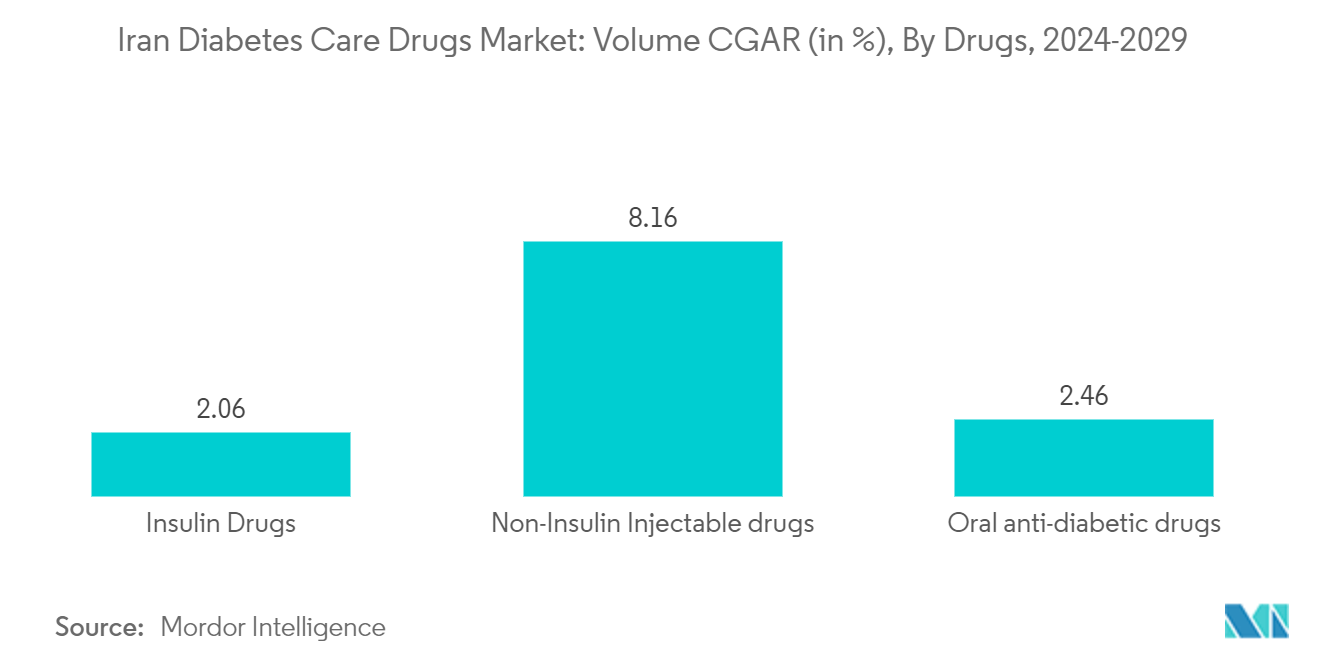Market Trends of Iran Diabetes Care Drugs Industry
Oral-Anti Diabetes Drugs Segment is Having the Highest Market Share in the Current Year.
The Oral-Anti Diabetes Drugs segment is expected to increase with a CAGR of over 3.8% during the forecast period, mainly due to the demand from the diabetes population, which was more than 5.7 million by the end of the current year.
People living with Diabetes in Iran confront financial difficulties. Pharmacies do not sell enough insulin to people with diabetes; instead, insulin is sold on the open market at a higher price. Sometimes a diabetic child's parent is unable to locate insulin. Insulin costs 20-30% of a family's monthly income for type 1 diabetic children and adults. This does not include the excessively high cost of test strips and other supplies.
In addition, insurance firms in Iran are lowering financial assistance for diabetes treatments. Because insulin is scarce, Iranian families with diabetes children adapt by limiting the number of carbs in their child's diet. Though food and lifestyle are highly helpful in managing blood glucose levels, they frequently fail and necessitate oral medication therapy. If the second phase of pharmacological therapy fails, multiple oral therapies will be used.
Multiple therapies will be optimized, and in the ultimate stages, it will be shifted to oral-injectable multiple treatments. With broad modifications in hyperglycemia prescription therapy, guidelines for regulating blood glucose levels have evolved. Considering these developments in diabetes care, the trend in glucose-lowering medicines and their efficacy in blood glucose is critical.
One of the most prevalent difficulties in patients is poor drug adherence. Many patients struggle to adhere to therapy suggestions. Adherence to oral hypoglycemic medications (OHAs) ranges from 36% to 93% in controlling type 1 and type 2 diabetes. Sulphonylureas are commonly used to treat type 2 diabetes. Patient compliance is critical to the efficacy of oral diabetes therapy. It became vital to emphasize the recent status of diabetic medication adherence among type 2 diabetes patients in Tehran and the cultural variances within the same Iranian community.
Through the Iran government's encouragement, the usage of Drugs increased over the forecast period.

The rising prevalence of diabetes in Iran is boosting the country's diabetes drugs market.
In Iran, diabetes is a leading cause of mortality, blindness, renal failure, heart attack, stroke, and amputation of lower limbs. According to estimates by the National Program for Prevention and Control of Diabetes, diabetes will affect 9.2 million Iranians by 2030. This steady and large rise in diabetes prevalence reflects Iran's high disease burden, particularly when diabetes-related comorbidities are included.
Through serious worldwide attempts to lower the burden of diabetes, Iran's National Program for Prevention and Control of Diabetes (NPPCD) has achieved significant progress in providing effective diabetes prevention for the general population and long-term treatment for diabetic patients.
Despite the NPPCD's ongoing efforts to provide local, regional, and subnational estimates of diabetes, the current state of type-specific status, natural history, comorbidities, quality and accessibility of care, indicators of control, diabetes-related complications, and burden of diabetes among patients with diabetes in Iran remains poorly characterized.
Thus, the above factors are expected to drive the market growth over the forecast period.


